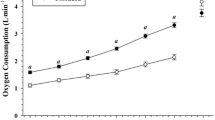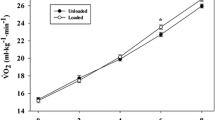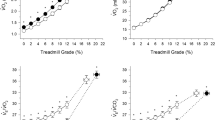Abstract
Purpose
The purpose of this experiment was to study breathing pattern and operating lung volume during 45 min of exercise with a heavy backpack (25 kg) and examine the effect of this exercise on respiratory muscle strength.
Methods
Fifteen males completed randomly ordered graded exercise tests on a treadmill with and without a correctly sized and fitted 25 kg pack. Subsequently, each subject completed, in random order, on separate days, 45 min of treadmill walking with and without the pack. Oxygen demand was matched between conditions (loaded: 3.01 ± 0.11 and unloaded 3.02 ± 0.11 L min−1).
Results
With load, breathing frequency (f B) and minute ventilation increased by 21.7 and 15.1 % (P < 0.05), respectively, while tidal volume (V T) and end-inspiratory lung volume (EILV) were reduced by 6.3 and 6.4 % (P < 0.05), respectively, compared to unloaded. Following loaded exercise, maximal inspiratory pressure decreased by 6.7 % (P < 0.05) with no change in maximal expiratory pressure. No changes in maximal inspiratory or expiratory pressures were observed following unloaded exercise. Despite equivalent oxygen demand, perceived exercise stress and breathing discomfort was higher (P < 0.05) in the loaded condition.
Conclusions
The mechanical disadvantage placed on the respiratory system during exercise with a heavy pack led to compensatory changes in breathing pattern and EILV, and a reduction in maximal inspiratory pressure post-exercise. We suggest that in an attempt to minimize the work of breathing, subjects adopted a shallow and frequent breathing pattern. However, this pattern increased deadspace and minute ventilation, which likely contributed to altered perceptions of exercise stress and breathing discomfort.



Similar content being viewed by others
Abbreviations
- fB :
-
Breathing frequency
- EELV:
-
End expiratory lung volume
- EILV:
-
End inspiratory lung volume
- FEV1 :
-
Forced expired volume in 1 s
- FVC:
-
Forced vital capacity
- IC:
-
Inspiratory capacity
- MIP:
-
Maximal inspiratory pressure
- MEP:
-
Maximal expiratory pressure
- TLC:
-
Total lung capacity
- VC:
-
Vital capacity
- \({\dot{\text{V}}}\)CO2 :
-
Carbon dioxide production
- \({\dot{\text{V}}}\)O2 :
-
Oxygen consumption
- V T :
-
Tidal volume
References
Abe D, Yanagawa K, Niihata S (2004) Effects of load carriage, load position, and walking speed on energy cost of walking. Appl Ergon 35(4):329–335
Al-Khabbaz YSSM, Shimada T, Hasegawa M (2008) The effect of backpack heaviness on trunk-lower extremity muscle activities and trunk posture. Gait Posture 28(2):297–302
American Thoracic Society (2005) Standardization of spirometry. Eur Respir J 26:319–338
Beekley MD, Alt J, Buckley CM, Duffey M, Crowder TA (2007) Effects of heavy load carriage during constant-speed, simulated, road marching. Mil Med 172(6):592–595
Borg GA (1982) Psychophysical bases of perceived exertion. Med Sci Sports Exerc 14(5):377–381
Butcher SJ, Rl Jones, Mayne JR, Hartley TC, Petersen SR (2007) Impaired exercise ventilatory mechanics with the self-contained breathing apparatus are improved with heliox. Eur J Appl Physiol 101(6):659–669
Dominelli PB, Sheel AW, Foster GE (2012) Effect of carrying a weighted backpack on lung mechanics during treadmill walking in healthy men. Eur J Appl Physiol 112(6):2001–2012
Faghy MA, Brown PI (2014) Thoracic load carriage-induced respiratory muscle fatigue. Eur J Appl Physiol 114(5):1085–1093
Hopkins SR, Gavin TP, Siafakas NM, Haseler LJ, Olfert IM, Wagner H, Wagner PD (1998) Effect of prolonged, heavy exercise on pulmonary gas exchange in athletes. J Appl Physiol 85(4):1523–1532
Johnson BD, Weisman IM, Zeballos RJ, Beck KC (1999) Emerging concepts in the evaluation of ventilatory limitation during exercise: the exercise tidal flow-volume loop. Chest 116(2):488–503
Miller JD, Hemauer SJ, Smith CA, Stickland MK, Dempsey JA (2006) Expiratory threshold loading impairs cardiovascular function in health and chronic heart failure during exercise. J Appl Physiol 101:213–227
Muza SR, Latzka WA, Epstein Y, Pandolf KB (1989) Load carriage induced alterations of pulmonary function. Int J Ind Ergon 3(3):221–227
Nelson MD, Haykowsky MJ, Mayne JR, Jones RL, Petersen SR (2009) Effects of the self-contained breathing apparatus on ventricular function during strenuous exercise. J Appl Physiol 106:395–402
O’Donnell DE, Hong HH, Webb KA (2000) Respiratory sensation during chest wall restriction and dead space loading in exercising men. J Appl Physiol 88(5):1859–1869
O’Donnell DE, Revill MR, Webb KA (2001) Dynamic hyperinflation and exercise intolerance in chronic obstructive pulmonary disease. Am J Respir Crit Care Med 164(5):770
Patton JF, Kaszuba J, Mello RP, Reynolds KL (1991) Physiological responses to prolonged treadmill walking with external loads. Eur J Appl Physiol 63(2):9–93
Sagiv M, Ben-Sire D, Sagiv A, Werber G, Rotstein A (1994) Left ventricular responses during prolonged treadmill walking with heavy load carriage. Med Sci Sports Exerc 3:285–288
Sheel AW, Romer LM (2012) Ventilation and respiratory mechanics. Compr Physiol 2(2):1093–1142
Sheel AW, Derchak PA, Pegelow DF, Dempsey JA (2002) Threshold effects of respiratory muscle work on limb vascular resistance. Am J Physiol Heart Circ Physiol 282(5):H1732–H1738
Stickland MK, Anderson WD, Haykowsky MJ, Welsh RC, Petersen SR, Jones RL (2004) Effects of prolonged exercise to exhaustion on left-ventricular function and pulmonary gas exchange. Respir Physiol Neurobiol 142(2–3):197–209
Stickland MK, Lindinger MI, Olfert IM, Heigenhauser GJF, Hopkins SR (2013) Pulmonary gas exchange and acid-base balance during exercise. Compr Physiol 3(2):693–739
Taylor NAS, Lewis MC, Notley S, Peoples GE (2012) A fractionation of the physiological burden of the personal protective equipment worn by firefighters. Eur J Appl Physiol 112(8):2913–2921
Tomczak SE, Guenette JA, Reid WD, McKenzie DC, Sheel AW (2011) Diaphragm fatigue after submaximal exercise with chest wall restriction. Med Sci Sports Exerc 43(3):416–424
Wasserman K (1987) Determinants and detection of anaerobic threshold and consequences of exercise above it. Circulation 76(6):29–39
West JB (ed) (2008) Respiratory physiology: the essentials, 8th ed. Baltimore, MD
White MD (2006) Components and mechanisms of thermal hyperpnea. J Appl Physiol 101:655–663
Author information
Authors and Affiliations
Corresponding author
Ethics declarations
Conflict of interest
There are no conflicts of interest.
Additional information
Communicated by Susan Hopkins.
Rights and permissions
About this article
Cite this article
Phillips, D.B., Stickland, M.K. & Petersen, S.R. Ventilatory responses to prolonged exercise with heavy load carriage. Eur J Appl Physiol 116, 19–27 (2016). https://doi.org/10.1007/s00421-015-3240-7
Received:
Accepted:
Published:
Issue Date:
DOI: https://doi.org/10.1007/s00421-015-3240-7




